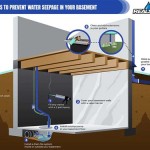What To Do After Flooded Basement
Basement flooding can happen due to various unfortunate circumstances, such as heavy rainfall, broken pipes, or sewer backups. When this occurs, it leads to a situation that provides a couple of options: ignoring the issue and hoping it will resolve itself or taking immediate action to mitigate the damage. It is much better to take action as soon as possible to prevent the issue from escalating.
Here are the steps to take after a basement flood:
1. Ensure Safety
First and foremost, ensure your safety before attempting any cleanup. Turn off the electricity to the basement and gas lines to prevent electrical shock or fire. If the water is still rising, evacuate the basement and wait until it recedes before entering. Never enter a flooded basement if the water is above your knees or if you suspect there are downed power lines in the area.
2. Call Your Insurance Company
Contact your insurance company to report the flood and initiate the claim process. Take pictures or videos of the damage for documentation purposes. Your insurance company will provide instructions on what to do next and may send an adjuster to assess the damage.
3. Remove Standing Water
Once it is safe to enter the basement, use a wet/dry vacuum or pump to remove standing water. Start from the lowest point in the basement and work your way up. If the water is too deep for a vacuum or pump, you may need to rent a submersible pump.
4. Dry Out the Basement
Once the standing water is removed, it is crucial to dry out the basement thoroughly. Open windows and doors to ventilate the area. Use fans or dehumidifiers to circulate air and remove moisture. If possible, remove any wet or damaged items from the basement to prevent mold growth.
5. Clean and Disinfect
After the basement is dry, thoroughly clean and disinfect all surfaces that came into contact with floodwater. Use a bleach solution or a commercial disinfectant. Pay special attention to areas where mold or mildew may grow, such as walls, floors, and furniture.
6. Repair Damage
Once the basement is clean and dry, you can begin repairing any damage caused by the flood. This may involve repairing drywall, replacing flooring, or fixing any broken pipes or appliances. If the damage is extensive, you may need to hire a contractor to assist with the repairs.
7. Prevent Future Flooding
To prevent future flooding, consider implementing measures such as installing a sump pump, waterproofing the basement walls, or grading the ground around your home to direct water away from the foundation. Regularly inspect your basement for any signs of water damage and address any issues promptly.

So Your Basement Flooded Now What Foundation Repair Permanent Solutions To Problems Thrasher News And Events For

How To Clean A Flooded Basement Reviews By Wirecutter

How To Deal With A Flooded Basement Disaster Recovery Hygiene Blog

3 Step Clean Up Plan After Your Basement Floods Waterproof Com

Post Flood Cleanup How To Clean A Concrete Basement Floor Csg Renovation

Flooded Basement Cleanup Who To Hire And Steps Take Bob Vila

Top 5 Steps To Take When Your Basement Floods D Bug Waterproofing Greensburg Pa

Expert Tips On What To Do If Your Basement Floods

My Basement Flooded Now What Ashworth Drainage

Basement Flooding Will Become More Common With Global Warming








